科学技術分野 ― 金属加工(エンジンバルブ)
<原文>
PDFファイルはこちらから→Click here for a PDF file.
黄色の部分については、この下に掲載してある<訳者からの連絡事項>をご参照下さい。
各画像の下に記載してあるFigure 1 〜8は、原文にはありません。
守り抜いた零戦の技術 三菱重、自動車部品で復活
2014/2/3 7:00
三菱重工業が戦前の航空機の製造技術を最新の技法で現代の自動車部品によみがえらせた。エンジンの軽量化や燃料効率向上につながる傘中空エンジンバルブの加工技術だ。実現には焼却処分を避けて技術を次代に引き継ごうとした戦中の技術者と、現代の技術で磨き上げた昭和と平成の鍛造技術者の姿があった。
■技術資料、終戦で廃棄の危機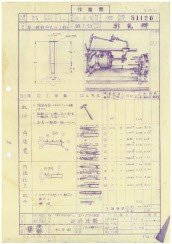
保存されていた青焼き資料 Figure 1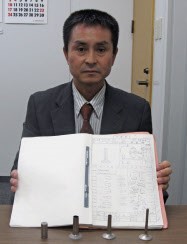
戦中の資料を持つ森井氏 Figure 2
「各社の反応は非常にいい。量産時期を前倒しする必要があるかもしれない」――。1月下旬に英独仏の大手自動車メーカーを訪問した工作機械事業本部(滋賀県栗東市)の工作部エンジンバルブ工作課傘中空チームの森井宏和主席技師は傘中空バルブの評価に手応えを感じていた。
絞り加工と穴開け加工を組み合わせる傘中空バルブはまず金属の棒の端をプレスし、出っ張ったバルブの頭を作る。その後、軸の部分に穴を開け、少しずつ冷間鍛造しながら細く絞っていく。バルブの傘の内部も空洞が広がる「傘中空」エンジンバルブができる。
軸に加え傘の部分も中空で従来より10〜20%軽い。エンジン内部の高温を逃がす機能も高い。棒の部分だけドリルで穴を開ける「中空」バルブより空洞部分が大きく、熱をよく伝えるナトリウムを傘の中にも充填するため、エンジンブロック内部の高温を早く外に逃がせるためだ。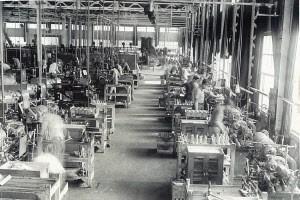
戦中にエンジンバルブを生産していた大幸工場 Figure 3
この技術は戦前・戦中に名古屋製作所大幸工場や、京都工場が軍用機のエンジンバルブ生産に活用した。当初の国産バルブは破損することが多く、欧州から設計図面を入手し工法を改良した。当時は量産最優先で、熱間鍛造を中心に600工程に及ぶ加工を人海戦術でこなした。月に8万本のバルブをなんと5000人の工員が造っていたという。
この加工技術の要領を詳細に記した技術資料は、終戦で廃棄の危機にさらされる。しかし、当時大学出の京都工場の若手技術者が個人的に「軍需関係の資料は焼却処分になるからどこかに隠した」。1966年に再び会社に戻し保管されていた。時はたち、森井氏はある時その資料を「こういう技術を我々は持っていた。いつか使え」と渡された。
■「一体成型でつくらないと意味ない」
しかし、1本数百円、絶え間ないコストダウンを迫られる量産車の部品で同じ方法は使えない。この技術を活用しようという試みは「鍛造で変形させる量が大きすぎ」、平成になるまで何度も失敗していた。
2007年に「エンジンバルブで新しい付加価値を創ろう」と始まったプロジェクト。森井氏は栗東で技術部門を統括していた樹神幸夫現取締役執行役員から「他社と同じではだめだ。溶接でつなぎ合わせるのではなく一体成型でつくらないと三菱重工がやる意味はない」とはっぱをかけられた。
社の内外に話を持っていくが、至る所で「この技術で量産するのは絶対無理だ」とさじを投げられた。そこに別件で吉村豹治氏が訪れた。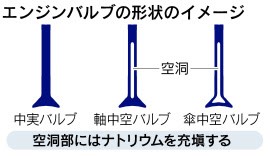
Figure 4
08年2月に森井氏は「傘中空の技術で自動車用エンジンバルブを量産できないか考えてほしい」と吉村氏に逆提案、94ページに上る戦前の図面の青焼き資料を見せた。4月から開発がスタートした。
吉村氏は名古屋の大幸工場に1957年に配属され、以来鍛造一筋。閉塞鍛造などの新技術を次々と開発した。86年に大幸工場が閉鎖されると重工を離れ、その後金型メーカーで役員になる。そこでも鍛造技術を研究し続けた。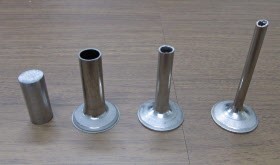
傘中空エンジンバルブ(1番右)の加工過程 Figure 5
青焼き資料にはどういうメーカーの製造装置を使うか、砥石の種類や粒径など傘中空バルブをつくるための詳細な作業指示がイラストを交えてびっしり書いてあった。
吉村氏が発案したのは耐熱性の高い高強度の合金を冷間鍛造する発想。「10以上の工法を考えたが、一つ目が当たった。コロンブスの卵のようなもの」という。森井氏は「車が空を飛ぶようなもの。無から有を生み出す吉村さんの発想はすごい」と舌を巻く。
■設計・ものづくり現場一体で実現
ただ、中空の棒を細く延ばしていく絞り加工が極めて難しい。うまくやらないと細い軸がつぶれてしまう。何回に分けて何トンの力をかけるか、変化させる金型の形など中小加工メーカーの協力を得て試行錯誤を繰り返した。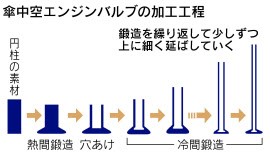
Figure 6
同社は今回、あらかじめ穴を開けてから絞り加工することで、精度が高い傘中空バルブを短時間で量産する技術を確立した。日本企業に加え、欧州の自動車メーカーにも新技術で攻勢をかける。
過去から学ぶべきは個別の技術だけではない。同社のものづくり技術部によると戦前・戦中の名古屋航空機製作所では零戦や重爆撃機などの製造段階で予想される不具合をあらかじめ設計に反映させ、開発期間を短くするコンカレント・エンジニアリング(CE)やフロント・ローディング(FR)の概念がすでに根付いていた。
当然コンピューターのない時代。平成の製造業が3次元(3D)CAD(コンピューターによる設計)や3Dプリンターを駆使して行う試みを「圧倒的な短納期を求められる戦時の要請から設計とものづくりの現場が一体となって実現した」という。みんなが大部屋に集まって議論する、まさに映画「風立ちぬ」の世界だ。
愛知県小牧市のミサイルや航空機のエンジンを製造する名古屋誘導推進システム製作所のギャラリーには、戦中の軍用機のエンジンや傘中空バルブやエンジンが展示されている。堤征一・名誘ギャラリー長も大幸工場で長く働いた。「整備士などが使うエンジンの透視図は手書きだが、CGと見間違えるほど精巧。当時のものづくりのレベルの高さが分かる」という。
ただ、伝承は容易ではなかった。名古屋航空宇宙システム製作所の資料室には零戦などの傍らに終戦で航空機生産が禁止になり「従業員の糊口(ここう)をしのぐためにつくった鍋やパン焼き器」が展示されている。売り上げの確保だけでなく「技術者を離散させないための方策」(総務統括部の伊藤敏彦氏)だった。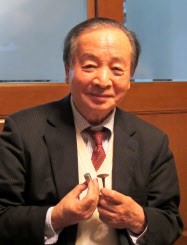
傘中空エンジンバルブを共同開発した吉村豹治氏 Figure 7
■大手自動車メーカーに出荷へ
航空機のわかる技術者は確保したが、サンフランシスコ講和条約を経て、三菱重工が航空機事業を再開したのは52年。戦後に進化した米国の航空機技術を導入するのに精いっぱい。「空白の7年間は大きかった」
傘中空バルブは今年度中に大手自動車メーカーに出荷を始める予定。2014年度に栗東に約10億円をかけ切断、熱処理、穴開け、絞り、ナトリウム注入などの一貫ラインを設ける。月産50万本の能力で、数年後には25億円を追加投資し同200万本にする計画だ。
三菱重工は傘中空技術を進化させることができた。資料を残した戦中の技術者、吉村氏、森井氏。誰が欠けてもこの技術はよみがえらなかった。ただ、数多くの研究所や事業所を抱える同社だけでは課題を解決できず、OBとはいえ、個人経営に近い吉村氏が解いたのも事実。
吉村氏は傘中空の技術開発を機に鍛造のコンサルティング会社、吉村カンパニー(名古屋市)を設立した。自動車メーカーなどに鍛造技術を提案している。三菱重工でも時折講演するが「大事な技術の継承者が管理職になって現場を離れてしまう」と嘆く。
■次世代に技術のバトン渡す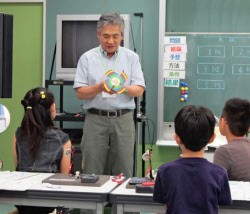
風車発電機を小学生と一緒に作る山之内氏 Figure 8
同社に限らず、大手企業は技能道場などをつくり、技能伝承を進めている。そこでは若手技術者が合宿なりして基本技能を吸収する。ただ「研修で過去の技術はコピーできても、最新技術と組み合わせて本当に武器となる技術に進化させるのはまた別」(森井氏)だ。
「電気はどうやってつくるか知ってるかい。発電機を回す方法はいろいろある」
三菱重工は風車を使った発電機作りなど、数年前から小学校で理科の出前授業を開いている。講師の一人が元社員の山之内憲夫氏。戦後初の国産旅客機、YSー11の設計に関わり、テストパイロットも務め、日本の航空産業の発展を支えた。昨夏も本社近くの小学校で他のメーカーの幹部OBと科学の楽しさを教えていた。
戦前から戦後、そして将来を担う子どもたちへ。地道にものづくりの技術のバトンを渡すことが日本の製造業の未来につながる。
(産業部 三浦義和)
<訳文>
PDFファイルはこちらから→Click here for a PDF file.
A technology used in zero fighters continued to be preserved, revival in automobile components, MHI
Feb 3, 2014 7:00
Mitsubishi Heavy Industries has revived a technology for manufacturing prewar aircrafts in today's automobile components with an up-to-date technique. It's a technology for forming a hollow-head engine valve that contributes to the weight reduction of the engine and the improvement of the fuel efficiency. What made the achievement possible are the efforts of a wartime engineer who had protected the technology from incineration to hand it over to the next generation and forging engineers of the Showa and Heisei periods who polished it up with today’s technology.
*Technical document, in danger of destruction
The preserved blueprint document Figure 1
Mr. Morii holding the wartime document in his hands Figure 2
"Reactions from the manufacturers are very positive. We may need to move up the mass-production schedule." - Mr. Hirokazu Morii, the principal engineer of the hollow head team of the engine valve engineering department of the engineering division of the machine tool business headquarters (Ritto City, Shiga Prefecture) was feeling a sense of expectation when receiving feedback about the hollow-head engine valve. He had visited British, German, and French major automobile manufacturers in late January.
When forming a hollow-head engine valve that can be created through a combination of drawing and punching processes, first, the end of the metal rod is pressed to be the head of the pulled valve. After that, a hole is punched in the stem portion, and the stem portion is drawn to form a narrow stem being cold forged little by little. Then, a "hollow-head" engine that has hollow space spread also inside the head of the valve is complete.
In addition to the stem, the head is also hollow, so the valve has been 10-20% lighter compared to the previous one.
It also has a high capability of releasing the high-temperature air out of the engine. This is because the hollow part is larger, spreading also into the head, where highly thermally conductive sodium can be accommodated, compared to the normal “hollow” valve created by drilling a hole into its stem portion only, and that allows the high-temperature air to be released out of the engine block quickly.
The Daiko Factory, in which engine valves were produced during the war Figure 3
This technology was utilized by the Daiko Factory of the Nagoya Works and the Kyoto Factory for the production of engine valves of military aircrafts. At earlier stages, domestically-made valves had been broken so often that forming methods were improved based on design drawings obtained from Europe. At that time, as the mass-production was the highest priority, as many as 600 process steps, mainly hot forgings, were performed by sheer force of numbers. Amazingly, it is reported that 5,000 workers were engaged in the production of 80,000 valves per month.
The technical document with the detailed descriptions of this processing technology was exposed to danger of destruction at the end of the war. But at that time, a university graduated young engineer in the Kyoto Factory personally "hid it somewhere assuming that military-related documents would be incinerated". As of 1966, the document has already been stored in the company. After a long time had passed, the document was handed over to Mr. Morii with a message, "Our company had this technology. Use it when needed sometime in the future."
*"Does not make sense unless molded integrally"
However, for components of today's mass-produced automobiles, which require the price range of hundreds of yen because of incessant needs for cost reductions, the same processing method as the wartime cannot be used. A number of attempts made to utilize this technology continued to result in failure until the Heisei period, due to the issue that "the amount of the part that needs to be forged was too large".
In 2007, a new project was started under the slogan of "Let's create an additional value with an engine valve." Mr. Morii was pushed by a current member of the Board of Directors and Executive Committee, Mr. Yukio Kodama, who was controlling the engineering divisions in Ritto, with a message "Doing the same things as other companies does not work. It does not make sense for Mitsubishi Heavy to develop the engine valve unless it is molded integrally, instead of by welded connection. "
Even though he approached people inside and outside of the company with this idea, everywhere he got a response "It is absolutely impossible to mass-produce using this technology." and the reaction of giving up. Just then, Mr. Ryoji Yoshimura visited him on another matter.
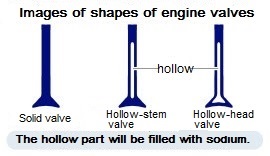
Figure 4
In February, 2008, Mr. Morii made a proposal to Mr. Yoshimura reversely, "I would like you to consider whether it is possible to mass-produce automobile engine valves using the technology of the hollow head." showing him a prewar blueprint drawing document of 94 pages. The development was started in April.
Mr. Yoshimura has been engaged solely in forging since he was assigned to the Daiko Factory in Nagoya in 1957, and constantly developed new technologies such as closed-die forging. He had left MHI when the Daiko Factory had been closed in 1986, and after that, became an official of a mold manufacturer, and continued the research of the forging technology there.
Working process to form the (rightmost) hollow-head engine valve Figure 5
The blueprint document was full with detailed instructions, including illustrations, such as manufacturers of the processing equipment to be used and types and grain sizes of the grindstones.
Mr. Yoshimura's proposal was an idea of cold forging a high-strength and high-heat resistant alloy. He said "The first one of the more than 10 processing methods I'd come up with made a hit. It's something like Columbus' egg." Mr. Morii said "This is like an invention of a car that can fly in the sky. Mr. Yoshimura's idea for creating existence out of nothing is great." being deeply impressed by Mr. Yoshimura's idea.
*Achieved by the integrated efforts made at designing and manufacturing floors
However, the drawing of stretching a hollow rod to make it thinner was extremely difficult. The thin stem could be crushed unless that is done under appropriate conditions. Trial and error, such as applying tons of pressure in several steps and changing the shape of the mold, were repeated with the cooperation of small-to-medium sized processing manufacturers..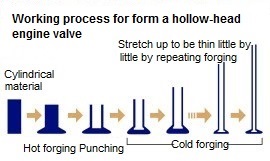
Figure 6
Mitsubishi Heavy Industries, this time, established the technology for mass-producing high-quality hollow-head valves in a short period of time by performing the process of punching holes prior to the drawing. They aggressively promote the sales with the new technology not only to Japanese companies but also to European automobile manufacturers.
What should be learned from the past is not only individual technologies. According to the manufacturing and engineering division of MHI, in the Nagoya Aircraft Works, before and during the war, the conceptions of concurrent-engineering (CE) and front-loading (FL) have already been rooted. These are conceptions of shortening the development time frame, by reflecting the failures predicted to occur during the stages of manufacturing the products such as zero fighters and heavy bombers in designing them, beforehand.
Of course, computers were not available at that time. It has been reported that "the attempts that can be performed by making full use of three-dimensional (3D) CAD (computer-aided design) and 3D printers in the manufacturing industry of the Heisei period, were achieved with the integrated efforts made both at designing and manufacturing floors because of the needs the wartime era, where overwhelmingly short time frame was required". The entire team was gathered in a large room for a discussion, just like in the world of the cinema, "The Wind Rises".
In a gallery of the Nagoya Guidance & Propulsion Systems Works located in Komaki City, Aichi Prefecture, where engines of missiles and aircrafts are manufactured, engines of wartime military aircrafts and engines with the hollow-head engine valves are displayed. Director of the gallery, Mr. Seiichi Tsutsumi also worked for the Daiko Plant for a long time. He says "Perspective views of engines that were created mainly for use by mechanics are precise enough to look like CG images, even though they were handwritten. They show the high level of the manufacturing technology of that time."
However, it was not easy to transfer the technology. In the reference room of the Nagoya Aerospace Systems Works, beside the exhibits such as zero fighters, "pans and toasters that were created to make living for employees" when the production of aircrafts was prohibited because of the end of the war, are displayed. This is one of the "measures" taken not only to maintain sales but also to "avoid dispersion of engineers" (according to Mr. Toshihiko Ito in the administrative control division).
Mr. Ryuji Yoshimura who co-developed the hollow-head engine valve. Figure 7
*Toward the shipments to major automobile manufacturers
Even though Mitsubishi Heavy acquired engineers who had knowledge of aircrafts, the company did not resume the aircraft business until 1952, after the San Francisco Peace Treaty. The best they could do was to introduce the U.S.'s aircraft technologies that had already made progress after the war. "The blank period of 7 years had a so large impact".
The company is scheduled to start shipping the hollow-head engine valves to major automobile manufacturers within this fiscal year. They will invest approximately one billion yen to build a facility in Ritto to perform a series of processes such as cutting, heat treatment, punching, drawing, and sodium injection on one line. It will start with a capacity to produce 500 thousand valves per month, and the company has a plan to make an additional investment of 2.5 billion yen after years to increase the capacity to 2 million per month.
Mitsubishi Heavy was able to make progress on the hollow-head technology. The wartime engineers who left the document, Mr. Yoshimura, and Mr. Morii contributed to this achievement. This technology would not have been revived if anyone among them had been dropped out. However, it is also a fact that the company, equipped with a lot of laboratories and facilities, was unable to solve the issue by themselves, and that Mr. Yoshimura, who has was running a business almost independently, although he was a former employee, was able to solve it.
Mr. Yoshimura took the occasion of the development of the hollow-head technology to establish a forging consulting company of Yoshimura Company (Nagoya City). The company proposes forging technologies to the clients such as automobile manufacturers. He sometimes gives a lecture also in Mitsubishi Heavy, though, regretting "The important successors get away from the fields once they go to the management positions."
*Pass the baton of the technology to the next generation
Mr. Yamauchi creating a windmill generator with elementary school kids. Figure 8
Not only MHI, other major companies are also promoting the transfer of the expertise by creating opportunities such as expertise seminars. In the seminars, young engineers absorb the basic expertise through activities such as camping. However, "even if it is possible to duplicate previous technologies through training, it is another thing to combine them with the up-to-date ones to make a new technology that can be a real strength" (according to Mr. Morii).
"Do you know how the electricity can be made? There are various ways to run a power generator."
Mitsubishi Heavy has been hosting visiting science classes at elementary schools for years on themes such as creating a power generator using a windmill. One of the instructors is a former employee, Mr. Norio Yamanouchi. He contributed to the development of the Japanese airline industry by being engaged in designing YS-11, the first domestically-made passenger aircraft after the war. He also served as a test pilot for the aircraft. Mr. Yamanouchi was showing the pleasure of the science at an elementary school near the headquarters together with a former executive of another manufacturer last summer also.
From the pre-war to the post-war, and to children who will lead the future, making steady efforts to pass the baton of the manufacturing technologies will lead to the future of Japanese manufacturing industry.
(By Yoshikazu Miura, Industrial Division)
<訳者からの連絡事項>
PDFファイルはこちらから→Click here for a PDF file.
| 原文 | 訳文 | 連絡事項 |
|---|---|---|
| 三菱重工業 | Mitsubishi Heavy Industries | 原文における左記の社名や略称については、使い分けの基準は無いようですので、それぞれ、最も近い英語の社名や略称に置き換えました。 |
| 三菱重工 | Mitsubishi Heavy | 直近の社名と間が空いているため、略称やthe companyにせずに、社名にしました。 |
| 三重工 | MHI | 上記との間隔が短いですが、the companyではわかりにくいため、略称を使用しました。 |
| 同社 | Mitsubishi Heacy Industries | 直近の社名と間が空いているため、略称やthe companyにせずに、社名にしました。 |
| 同社 | MHI | 上記との間隔が短いですが、the companyではわかりにくいため、略称を使用しました。 |
| 同社 | the company | 直近のMitsubishi Heavyとの間隔が短いことと、「(研究所や事業所を抱える)会社だけでは〜できなかった。」という文脈にも合うと考えたことにより、この表現にしました。 |
| 同社 | MHI | 直近のMitsubishi Heavyとの間隔が短いですが、this companyとすると、直後の「大手企業(other major companies)」と単語が重複するため、略称にしました。 |
| 戦中の軍用機のエンジンや傘中空バルブやエンジン | engines of wartime military aircrafts and engines with the hollow-head engine valves | 「戦中の軍用機のエンジン」と「傘中空バルブが搭載されたエンジン」という意味であると判断しました。 |
| フロント・ローディング(FR) | front-loading (FL) | (FR)は(FL)を意味すると判断しました。 |